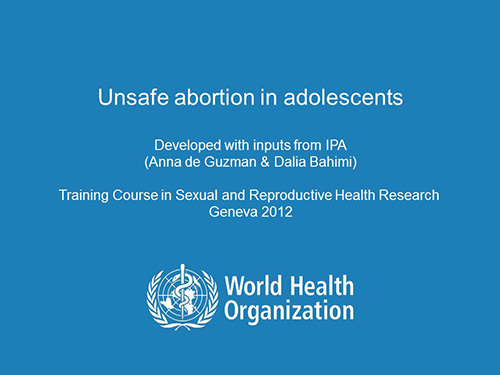Adolescent sexual and reproductive health - Course files
Unsafe abortion in adolescents
World Health Organization
From Research to Practice: Training Course in Sexual and Reproductive Health Research 2012
October 8, 2012 - Geneva
Download the complete document
World Health Organization. Unsafe abortion in adolescents. Paper presented at: Training Course in Sexual and Reproductive Health Research; 2012 Oct 8; Geneva. Available from: https://www.gfmer.ch/SRH-Course-2012/adolescent-health/Unsafe-abortion-adolescents-WHO-2012.htm
Topics covered in the module
- How many unsafe abortions occur in adolescents? And where do they occur?
- What are the consequences of unsafe abortion in adolescents?
- Why do unintended pregnancies occur in adolescents? How could they be prevented?
- Why do unsafe abortions occur and why are they more likely to result in serious complications in adolescents? How can they be prevented?
Essential reading
WHO. Orientation programme on adolescent health for health-care providers. WHO. Geneva. 2006.
Module I is titled: Unsafe abortion in adolescents.
A range of individuals and institutions have important roles in promoting healthy development in adolescents, and in preventing and responding to health problems challenging this population group. Health-care providers (HCP) have important contributions to make in both these areas. However, situation analyses and needs assessment exercises carried out in different parts of the world point to shortcomings in their professional capabilities and in their 'human qualities' as a result of which they are unable and oftentimes unwilling to deal with adolescents in an effective and sensitive manner. To bridge this gap, the Department of Child and Adolescent Health and Development (CAH) of the World Health Organization (WHO) is developing the Orientation Programme on Adolescent Health for Health-care Providers (OP) with other partners. The OP is a joint effort of the Commonwealth Medical Association Trust, UNICEF and WHO.
The materials consist of a handout for participants and of a facilitator's guide for the overall course (course director guide) and for all the modules. It provides detailed guidance on how to run each module. In addition it contains tips for the trainers, lecturing aids such as overhead slides in electronic form with accompanying talking points and study materials. Facilitator's guide, handouts for participants, the lecturing aids and study materials are all available on a CD ROM. The Orientation programme is available in English, French and Russian.
This toolkit has been developed by the IPAS. It was published in 2011.
It has been designed to provide information and guidance on delivering and ensuring access to appropriate induced abortion care for young women (ages 10-24). It provides experienced trainers with the background information, materials, instructions and tips necessary to effectively facilitate training sessions.
Since existing research demonstrates few differences in the clinical needs of young women compared to adults, the toolkit contains more on advocacy, partnerships and service delivery than clinical issues. It is a global resource for health care providers, trainers, administrators and technical advisors of abortion care programs, but some materials also can be used to engage young people, policymakers, community groups, donors, advocates and other stakeholders.
Assignment
Option 1:
Please respond to this if you are a health worker (doctor, midwife, nurse, clinical officer, psychologist, health educator) or social worker.
Are you aware of your country’s laws and policies on the provision of abortion services ? If so, please list the conditions under which abortion services can be legally provided in your country?
Option 2:
If you are not a health worker please cite a recent article in the media in which abortion is discussed and write a commentary on it.
